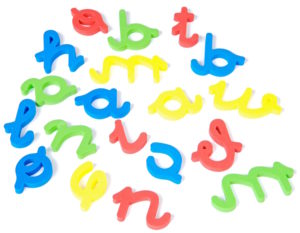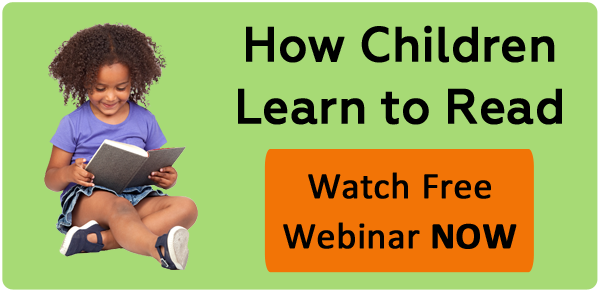
“My child is 7 years old and is not reading.”
“Help! My child is ten years old and is reading on a second grade level”.
“My 7th grader is making D’s and F’s. What can I do?”
Over the years, many parents have asked for my help with their children’s academic progress.
Time after time, the children who were falling behind in school were poor readers. They also did not have a good understanding of the relationship between sounds and letters.
Many ten-year-olds could tell me the sounds of only five of the twenty-six letters of the alphabet.
We always did what we had to do…start at the beginning, and develop awareness that words are made out of sounds, that each letter represents a sound, and that words and sentences make sense.
The time frame of when children begin to read lasts about five years. Some children may begin to read as young as four-and-a-half years and others as late as nine years.
The important thing is to be sure your child is in a language-enriched environment, learning the sounds of the letters and learning to hear the sounds in the words.
My experience is that children with minds that are more oriented to mathematical and spatial skills, tend to begin reading later.
If the child has been in an encouraging environment, by the time they are twelve, there is usually not a reading skill difference between the early and late reader.
If your child is not a fluent reader by age seven, he or she may be encountering some obstacles that need adult assistance.
For many young readers, visual memory has not completely formed on several letters.
They will often confuse the following letters:
d and b,
p, q and g,
r and n,
w and m,
t and f,
i and l,
u,h and n.
As you can quickly count, this confusion can involve over half the alphabet. No wonder it is frustrating for them to try and read. No wonder some kids just give up!
In cases of letter confusion, you must go back to the beginning and develop letter/sound recognition, for your young reader is trying to make sense of symbols before he is ready. Work on sound /letter recognition until he can correctly identify sixteen letters with their sounds. Then take the next step of introducing him to one word at a time with the letters he has mastered.
Another obstacle your child might encounter is not being able to read left to right.
Some children will start decoding a word from the right or in the middle. Their eye muscles may be weak and need practice in moving left to right. To help your child overcome this obstacle, use one-word vocabulary cards and place a sticker on his left hand to help him to remember to start on the left. Remind him that words make sense, and that each word he tries to read will be a word that is in his spoken vocabulary.
The next obstacle is not having the ability to see the spaces between the words.
To someone who is having this difficulty, a sentence looks like one huge, horrible word. Making booklets of three word phrases with a picture clue will help your child begin to see the spaces between the words. (See last week’s article, Steps to Reading.) Encourage your child to place a finger at the end of a word before starting to write the next word, so the spaces become more evident.
Reading from the top of the page, line by line, to the bottom, is another difficulty for the new reader.
Many times a young reader’s eye muscles are not developed enough to move left to right and back again to pick up the next line. Making small booklets with two lines of writing per page will help your beginning reader exercise her eyes and develop success with reading.
Difficulty picking out letter patterns is another obstacle.
Some young readers will have difficulty seeing phonograms, two or more letters that make a different sound, such as “sh”, “th”, “ch”, “oi”, “oa”, “oo”, and the vowel-consonant-silent “e” combination as in bike. Making lists of words with these letter combinations will help your reader develop a visual memory of these combinations. Going through the newspaper and looking for certain phonograms is also a fun activity.
There can be many obstacles to reading development, usually due to trying to jump a step developmentally. Every person’s brain develops at a different rate, but in observable developmental patterns. Reading success is dependent on a foundation of phonemic awareness and letter/sound recognition.
Remember, to assure reading success, start at the beginning by introducing each letter and its unique sound.
Be aware that your child might encounter developmental obstacles due to their unique brain development and that these obstacles might take some time to overcome. Always encourage your child and keep your home language enriched.
These are the keys for reading success.


In your experience have you had success with children who are dyslexic and haven’t developed phonemic awareness or letter sound recognition? The child I am thinking of can recognise the letters in his name and the sounds of two letters in his name. I am sorry this is perhaps not what you expected in a comment. I actually tried various ways to bring in phonemic awareness and letter sound recognition ( following sound and action for each letter – Jolly phonics and making up a story with 5 words at a time) He was able to remember the story but could not remember the letters learnt. He was getting frustrated in not being able to remember. So I backed off completely and waiting for some signs of readiness from him to start again. He is very interested in books. He goes through books, makes his own books and writes stories ( he tells the story and someone writes it for him and then he copies), he also likes to make a copy of the book that he loves listening to from the one sentence reader series. Sorry for this long account, but he will turn 9 at the end of this academic year and I would love to help him to read by himself. Many Thanks.
Suseela,
When I work with older children, which I consider to be the 6 to 12-year-old, we go back to the very beginning. We learn letters and sounds.
Usually for the older child who is not a fluent reader, I’ll find that they recognize less than ten letters and their sounds.
With the letters and sounds they do know, we’ll work on building words with the moveable alphabet. Let’s say the child knows o, a, b, g, f, t,s and l. I’d build the word “oat” on a rug using moveable. Then I’d put out boat, goat, float underneath oat. I’d help the child realize he could read and spell those words. I’d encourage him to write in moveable and/or on paper. He could even get a sentence from those words: Goats float in boats.
Encourage him to copy stories. That will help with visual memory also. Keep him writing.
For any child struggling with reading, go back and focus on systematically learning each letter and its sound.
You have to help build that foundation for reading success. I don’t know of any other way. I’ve seen it work in almost every situation.
Suseela, Your description got me thinking about the purpose of reading, to gain meaning with language. I encourage reading together as long as possible to build reading skill through a long relationship. To read aloud and listen to a story aloud uses our very ancient skills of oral language. Written language is a more recent development and uses skills acquired later in development.
Writing to Read was a program in wide use in the ’80’s. A child who can dictate a story in their own words has a good chance of reading that story fluently.
This can be applied to an exercise of hearing a story, even page by page, to reflect each stage of he story in an individual’s own words, and read through the dictated version. Also this kind of exercise can reveal the current usage of words and syntax which may be in variance from the words on the page of the original story. I see this kind of word play/story reflection as an exercise of language, not a plateau of reading skills.
Also, I believe a new approach with some fun and spontaneous interaction can lighten up the difficulty of gaining new abilities.
Suseela: If this child is 9 and doesn’t know his sounds and you think he has dyslexia, he needs special intervention from a dyslexia specialist. Have you had him tested for dyslexia. There is a lot of help out there. If you need help with any intervention please write to me.